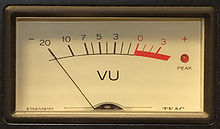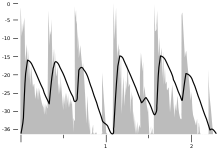VU meter
A VU meter is often included in analog audio equipment to display a signal level in Volume Units.




It is intentionally a "slow" measurement, averaging out peaks and troughs of short duration to reflect the perceived loudness of the material. It was originally developed in 1939 by the combined effort of Bell Labs and broadcasters CBS and NBC, for measuring and standardizing the levels of telephone lines. The instrument used to measure VU is called the volume indicator (VI) instrument. Most users ignore this and call it a VU meter.
Volume Unit (VU) defined: The reading of the volume indicator shall be 0 VU when it is connected to a 600-ohm resistance in which is flowing one milliwatt of sine-wave power at 1000 cycles per second.[1][2]
The typical VU scale is from −20 to +3. The rise and fall times of the meter are both 300 milliseconds, meaning that if a constant sine wave of amplitude 0 VU is applied suddenly, the meter will take 300 milliseconds to reach the 0 on the scale. It behaves as a full-wave averaging instrument, and is not optimal for measuring peak levels.
The behaviour of VU meters is defined in ANSI C16.5-1942, British Standard BS 6840, and IEC 60268-17.
How to use a VU meter
Tape and cassette decks typically used physical meters similar to needles on a compass. The needles would be "pegged" when they hit the physical pegs which stopped the maximum motion of the needle. The first high-fidelity deck, the Advent, used only one meter, which could be switched to average both channels, or either channel, but this was never adopted by any other design. When LEDs were developed, they were often used to indicate peak levels, and later arrays of them replaced mechanical meters, and later LCD and fluorescent displays which are not subject to Newton's laws of motion to limit reaction time. Computer recording software often emulates an array of LEDs. The Nagra V, the latest digital version of a professional reel-to-reel recorder dating from the 1960s still uses analog meters.
Peak levels may be displayed in addition to the current level. As a rule, recording levels should be set so that they do not exceed the red area beyond 0 VU or only rarely. If the level is set too low, noise levels will be high. If set too high, the sound quality and frequency response is typically poorer at high recording levels, and clipping effects can be especially severe for a digital recording system. Systems tailored for voice often incorporate automatic level control, usually not defeatable in inexpensive recorders.
VCRs only included VU meters when, rarely, they provided a manual level control, which is typically required for recording live music rather than compressed television or radio broadcasts.
See also
- Peak programme meter
- Programme level
- Peak meter
- Audio equipment
- Loudness monitoring
- Mixing console
- Crest factor
- Decibel#Acoustics
- Nominal level
External links
- Rane Pro Audio Reference definition for VU meter
- Q&A on the Standard Volume Indicator by John McNight
- A New Standard Volume Indicator and Reference Level by Chinn, Gannett & Morris
- The Bewildering Wilderness - "Navigating the complicated and frustrating world of audio standards"
- Audio Level Meters
- VU meter video
